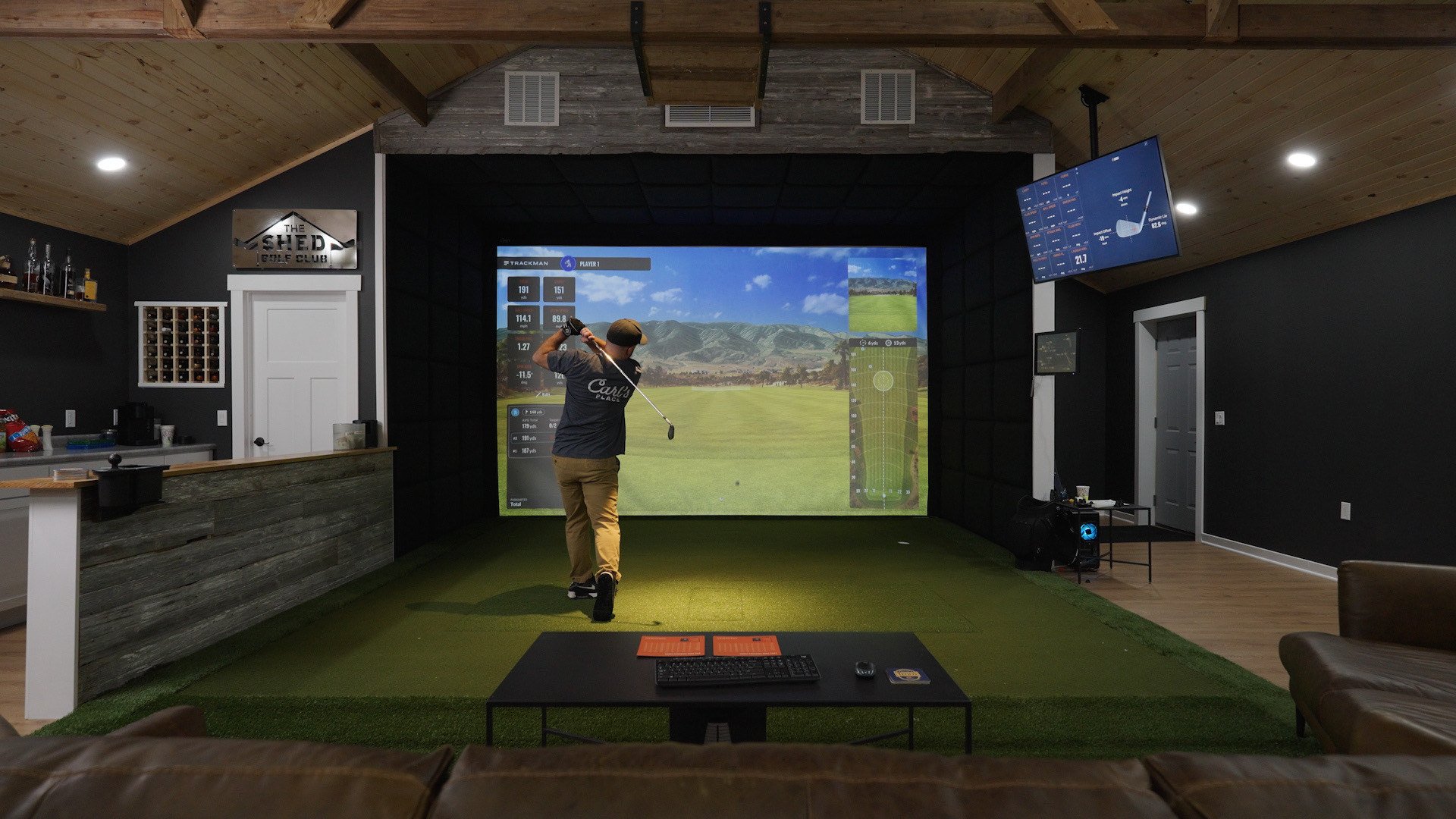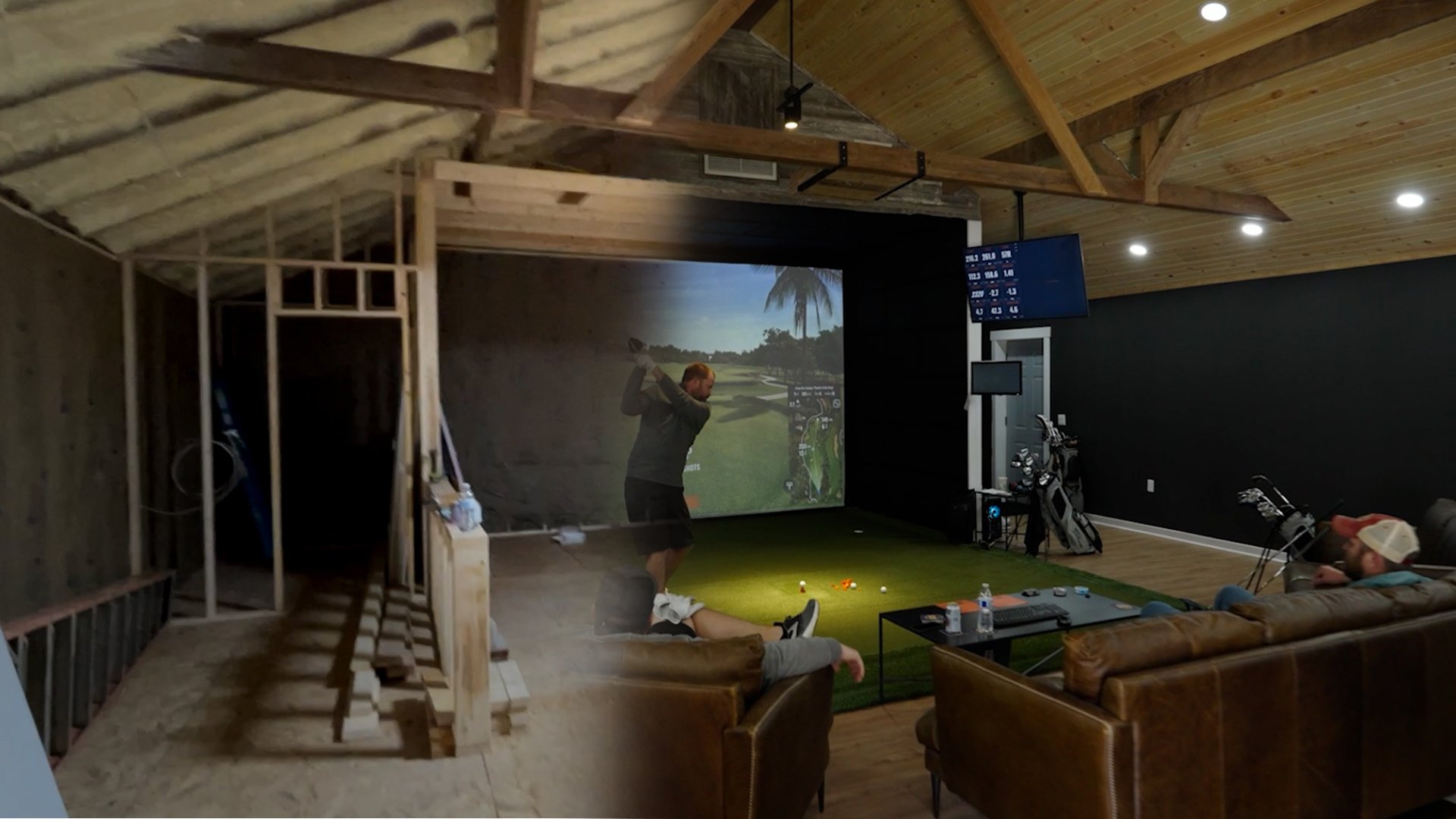Unearth an indoor golf haven in your low-ceiling basement! How to excavate your basement to get a full golf swing in your own basement golf simulator build.
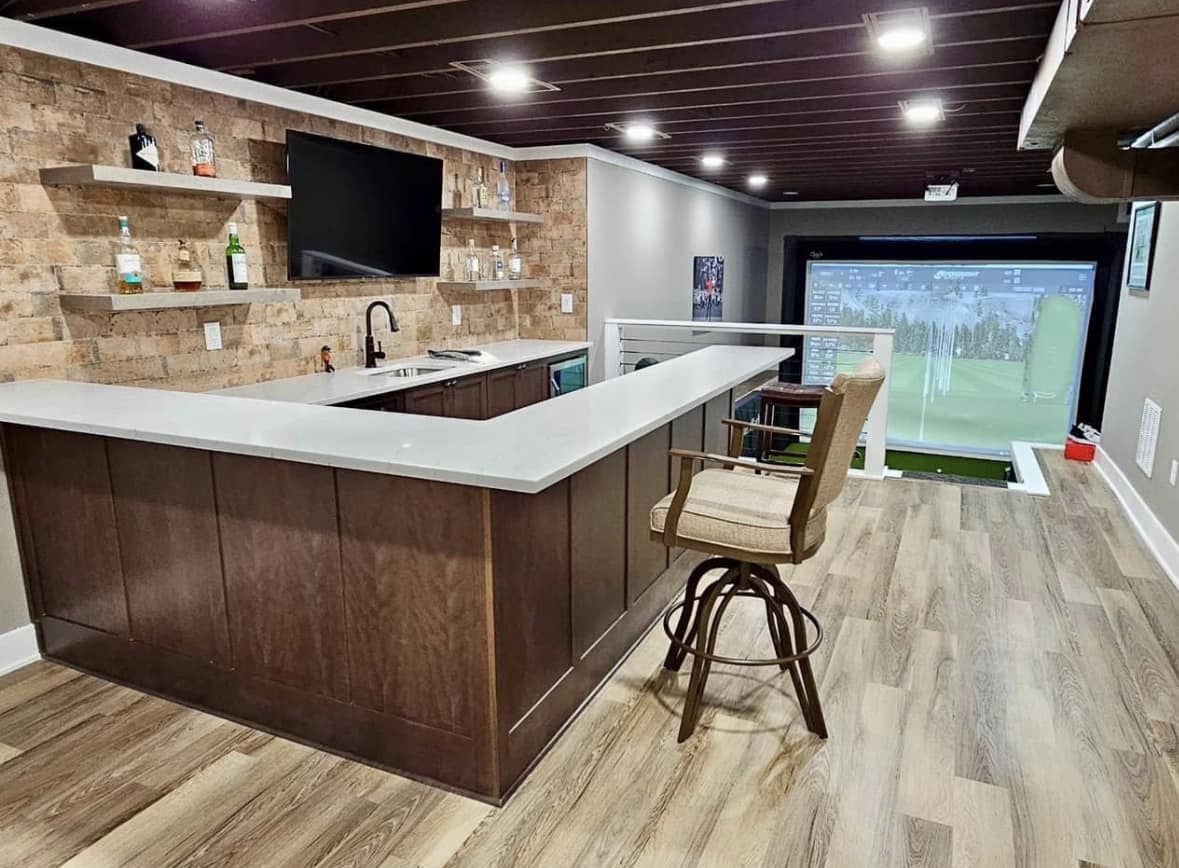
Photo courtesy of James L.
Basements often lack sufficient height for a golf simulator.
Many golfers can swing some clubs with 9-foot ceilings, but if you want to be able to swing all clubs (including a driver), you’ll want 10-foot ceilings.
Discover how to transform your basement into the ultimate golfing haven by excavating for a golf simulator. Learn about the necessary preparations, excavation process, and key considerations to create the perfect space for practicing your swing indoors.
Choosing a Basement Golf Simulator
When it comes to choosing a golf simulator for your basement, there are several key factors to consider. Here are some tips to help you make the right decision:
1. Space requirements: Measure the dimensions of your basement. Consider the width, depth and height of the space. Check out our guide on Measuring for a Golf Simulator - this will help you determine if there's enough room for your swing and the simulator's components. If your low-ceiling basement doesn't have enough height for a full golf swing, consider excavation as a solution.
2. Technology and features: Golf simulators come with a variety of features, such as swing analysis, virtual courses, and multiplayer capabilities. Determine which features are important to you. Some of these options, like the ability to easily host multiplayer (leftie and rightie golfers) will affect how much space you need for your golf simulator.
3. Budget: Set a budget for your golf simulator and stick to it. Consider both the upfront cost of the simulator and any additional equipment or accessories you may need. Remember to factor in installation and maintenance costs as well. Check out this guide on How Much A Golf Simulator Costs for more info.
4. Brand and reputation: Research different golf simulator brands and read reviews from other users. Look for a reputable brand that offers quality products and good customer support.
5. Test before you buy: If possible, visit a golf simulator facility or demo center to test out different models. This will give you a better idea of the simulator's performance and help you make an informed decision. Carl’s Place has an appointment based showroom for those near southern Wisconsin who want to check out some of the technology. Contact our customer service team to schedule your visit.
6. With a big project like this, you’ll want to think about installing a wall-to-wall, floor-to-ceiling, built-in golf simulator that provides the most immersive experience.
By considering these factors and doing your research, you'll be able to choose the right golf simulator for your basement and enhance your indoor golfing experience.
Excavating Your Low-Ceiling Basement for a Golf Simulator
Preparing to Dig Out Your Basement for a Golf Simulator
If you decide excavating is the way you can get the basement golf simulator of your dreams, it's important to properly prepare your basement. Start by clearing out any items or furniture that may be in the way. This will give you a blank canvas to work with and make the excavation process easier.
Next, assess the structural integrity of your basement. You'll want to ensure that your foundation is strong enough to support the rest of your house while you excavate the portion of the basement you’ve designated for a golf simulator. If there are any cracks or signs of damage, it's important to address them before proceeding with the excavation.
Additionally, you may need to hire a professional to inspect the electrical and plumbing systems in your basement. Excavation can disrupt these systems, so it's crucial to make sure everything is in good working order before you start digging.
Finally, consider any permits or regulations that may be required for excavating your basement. Depending on your location, there may be specific guidelines or restrictions that you need to follow. It's important to do your research and obtain any necessary permits to avoid any legal issues.
By properly preparing your basement for excavation, you'll set yourself up for a successful project.
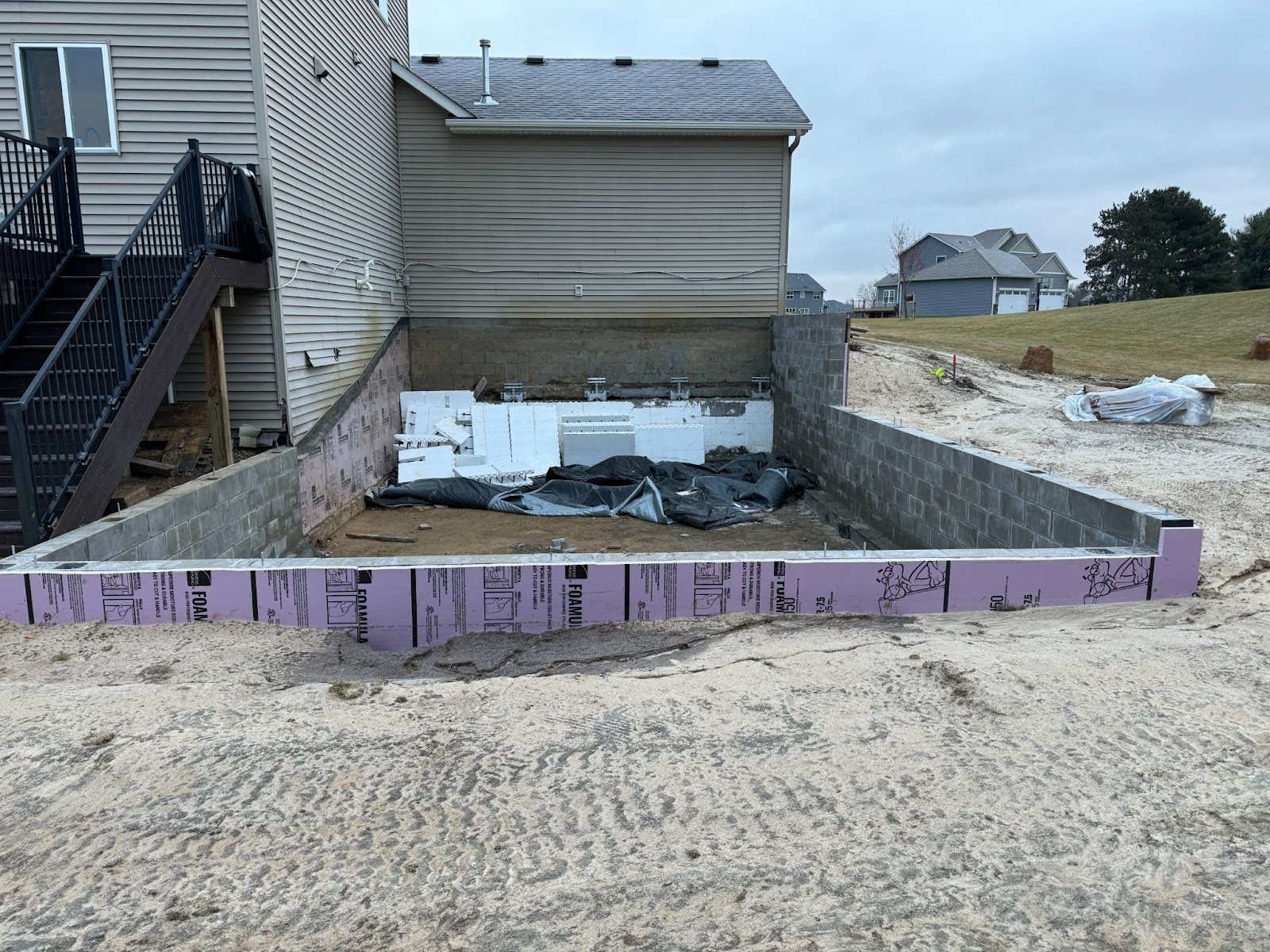
Understanding the Excavation Process
Digging out your basement for a golf simulator involves a series of steps to ensure a safe and efficient process. We highly suggest you hire an expert as excavating your basement could be a dangerous job with unforeseen repercussions. Here's a breakdown of the typical excavation process:
1. Marking and measuring: Before you start digging, you'll need to mark and measure the area where the golf simulator will be installed.
2. Digging: Using excavation equipment such as a backhoe or mini excavator, you'll begin digging out the designated area. It's important to follow the marked measurements and dig to the appropriate depth.
3. Removing debris: As you dig, you'll accumulate a significant amount of dirt and debris. It's important to remove this debris from your basement to create a clean workspace and prevent any safety hazards.
4. Leveling and compacting: Once the area is excavated, it's crucial to level and compact the soil to create a stable base for the new golf simulator area. This will help prevent any shifting or settling in the future.
5. Installing support structures: Depending on the design of your golf simulator room, you may need to install support structures such as beams or columns. These structures will help distribute the weight of the simulator and ensure the stability of your basement.
By understanding the excavation process and following these steps, you'll be well on your way to creating the perfect space for your golf simulator.
Designing the Perfect Golfing Space
Now that your basement is excavated and you've chosen the right golf simulator, it's time to design the perfect golfing space. Here are some tips to help you create a functional and aesthetically pleasing environment:
1. Lighting: Adequate lighting is crucial for a realistic and enjoyable golfing experience. Consider installing overhead lights or track lighting to ensure that your golf simulator area is well-lit. You may also want to add adjustable lighting options to create different atmospheres.
2. Flooring: Choose a durable and comfortable flooring option for your golf simulator area. One of the most popular options is to install foam puzzle-piece flooring to put under your choice of turf. That will provide a cushioned surface and a feel of a real golf course. This also provides flexibility if you want to cut out a space for your hitting mat so that it is flush with the rest of your turf.
3. Wall decor: Add some personality to your golfing space by decorating the walls. Hang golf-themed artwork, display your golf clubs or memorabilia, or even install a mini putting green on one of the walls.
4. Soundproofing: To minimize noise and create a more immersive experience, consider soundproofing your golf simulator area. This can be done by installing acoustic panels or soundproof curtains.
5. Ventilation: Ensure that your basement has proper ventilation to prevent the buildup of stale air and maintain a comfortable temperature. Consider installing vents or fans to improve air circulation.
6. Seating and storage: Depending on the size of your basement, consider adding seating and storage options. A comfortable chair or sofa will allow you to relax between swings, while shelves or cabinets can be used to store your golfing equipment and accessories.
By paying attention to these design elements, you'll be able to create a golfing space that not only enhances your indoor practice sessions but also reflects your personal style and taste.
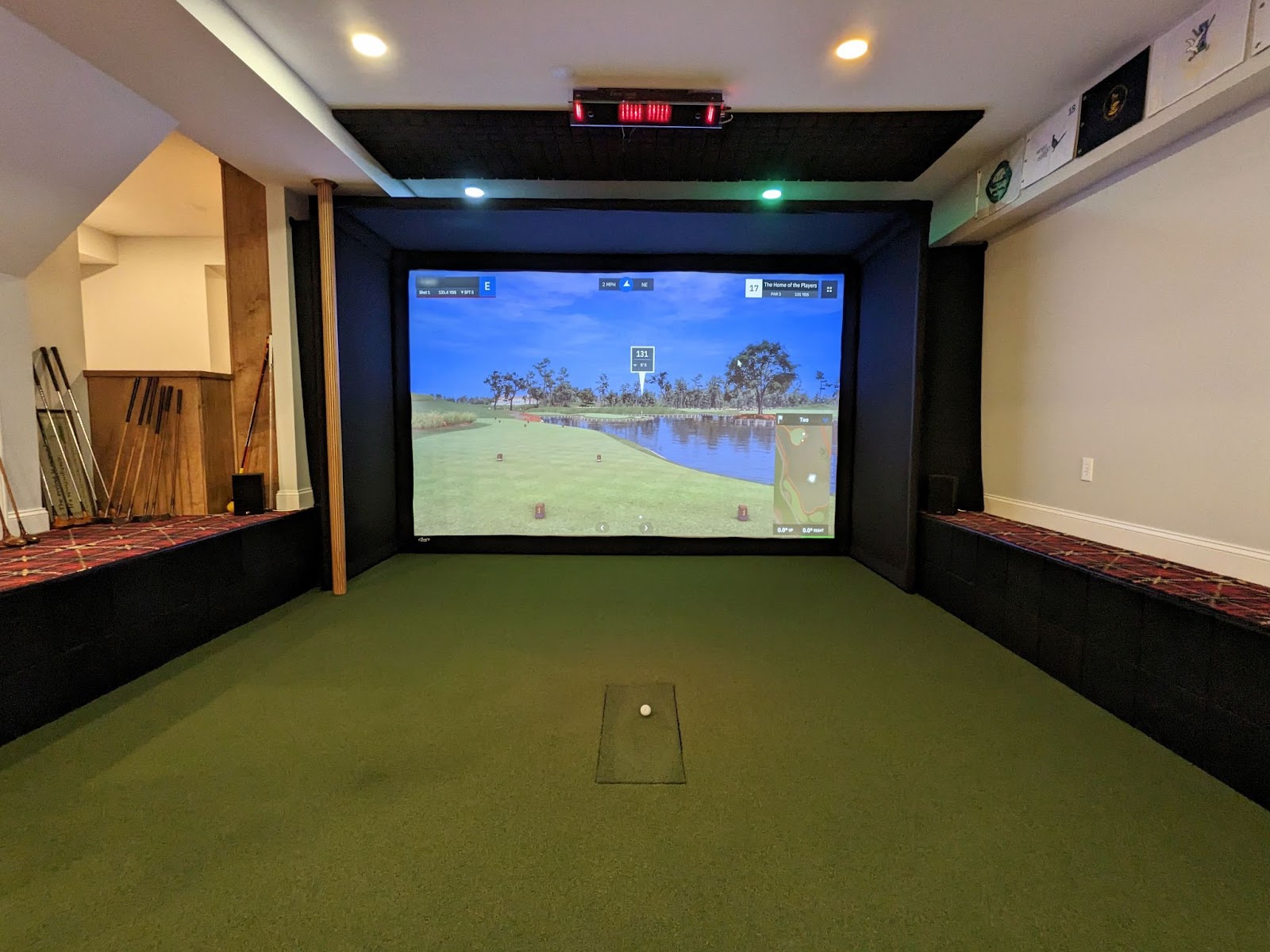
Final Touches and Safety Measures
As you near the completion of your basement excavation for a golf simulator, there are a few final touches and safety measures to consider:
1. Safety precautions: Keep the hitting and swing area free of objects and people. If you plan to have furniture in your basement golf simulator room, make sure it is far enough away from the swing area that people using the furniture will not get struck by a club or ball.
2. Maintenance and upkeep: Regularly inspect and maintain your golf simulator and the surrounding area. Clean the simulator screens, keep your hardware and software up to date, check for any loose or damaged components, and address any issues promptly to ensure optimal performance and longevity.
3. Enjoy your new golfing haven: Once everything is in place, it's time to enjoy your newly excavated basement and golf simulator. Invite friends over for a friendly competition or use the space for solo practice sessions. Make the most of your indoor golfing haven and watch your swing improve with each swing.
By considering these final touches and safety measures, you'll be able to create a safe and enjoyable basement golfing space for practicing your swing.
Need more ideas on designing a golf simulator room in your basement, spare room, garage or shed? Check out these Golf Simulator Room Design Ideas.
